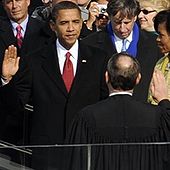 The United States has operated under a two-party system for most of its history. For elective offices at most levels, state-administered primary elections choose the major party nominees for subsequent general elections. Since the general election of 1856, the major parties have been the Democratic Party, founded in 1824, and the Republican Party, founded in 1854. Since the Civil War, only one third-party presidential candidate—former president Theodore Roosevelt, running as a Progressive in 1912—has won as much as 20% of the popular vote.
The United States has operated under a two-party system for most of its history. For elective offices at most levels, state-administered primary elections choose the major party nominees for subsequent general elections. Since the general election of 1856, the major parties have been the Democratic Party, founded in 1824, and the Republican Party, founded in 1854. Since the Civil War, only one third-party presidential candidate—former president Theodore Roosevelt, running as a Progressive in 1912—has won as much as 20% of the popular vote.Within American political culture, the Republican Party is considered center-right or "conservative" and the Democratic Party is considered center-left or "liberal". The states of the Northeast and West Coast and some of the Great Lakes states, known as "blue states", are relatively liberal. The "red states" of the South and parts of the Great Plains and Rocky Mountains are relatively conservative.
The winner of the 2008 presidential election, Democrat Barack Obama, is the 44th U.S. president. All previous presidents were men of solely European descent. The 2008 elections also saw the Democratic Party strengthen its control of both the House and the Senate. In the 111th United States Congress, the Senate comprises 57 Democrats, two independents who caucus with the Democrats, and 41 Republicans; the House comprises 255 Democrats and 178 Republicans (two seats are vacant). There are 26 Democratic and 24 Republican state governors.